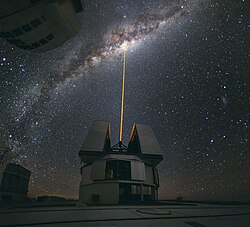Adaptive optics
Adaptive optics is a technology to improve the performance of optical systems by reducing the effects of rapidly changing optical distortion. It is commonly used on astronomical telescopes to remove the effects of atmospheric distortion.
Adaptive optical works by measuring the distortion and rapidly compensating for it either using deformable mirrors or material with variable refractive properties. While the idea was theoretically understood for some time, it was only advances in computer technology during the 1990s that finally made the technique practical.
Adaptive optics should not be confused with active optics, which works on a longer timescale to correct the primary mirror geometry itself. The simplest form of adaptive optics is tip-tilt correction, which corresponds to correction of the tilts of the wavefront in two dimensions (equal to correction of the position offsets for the image). This is performed using a rapidly moving tip-tilt mirror which makes small rotations around two of its axes.
A significant fraction of the distortion introduced by the atmosphere can be removed in this way. Tip-tilt mirrors are widely used in night time and solar telescopes, to correct the effect introduced by Earth's atmosphere on the light path and improve image quality.
Tip-tilt mirrors are effectively segmented adaptive optics mirrors with only one segment which can tip and tilt, rather than having an array of multiple segments which can tip and tilt independently.
Adaptive Optics Media
A laser beam directed toward the centre of the Milky Way. This laser beam can then be used as a guide star for the AO.
Illustration of a (simplified) adaptive optics system. The light first hits a tip–tilt (TT) mirror and then a deformable mirror (DM) which corrects the wavefront. Part of the light is tapped off by a beamsplitter (BS) to the wavefront sensor and the control hardware which sends updated signals to the DM and TT mirrors.
A deformable mirror can be used to correct wavefront errors in an astronomical telescope.
Other websites
- Description of Active & Adaptive Optics E.S.O.
- Adaptive Optics Tutorial at CTIO Archived 2021-06-01 at the Wayback Machine A. Tokovinin
- Research groups and companies with interests in Adaptive Optics
- NSF Center for Adaptive Optics at UC Santa Cruz
- Center for Astronomical Adaptive Optics at The University of Arizona Archived 2008-03-10 at the Wayback Machine
- Using Adaptive Optics to image photoreceptors Archived 2009-03-03 at the Wayback Machine
- Gemini's Laser Vision Reveals Striking New Details in Orion Nebula[dead link]
- Adaptive optics pinpoints on black holes Archived 2007-09-29 at the Wayback Machine
- Uranus in 2004 Archived 2008-02-27 at the Wayback Machine (with and without AO)







